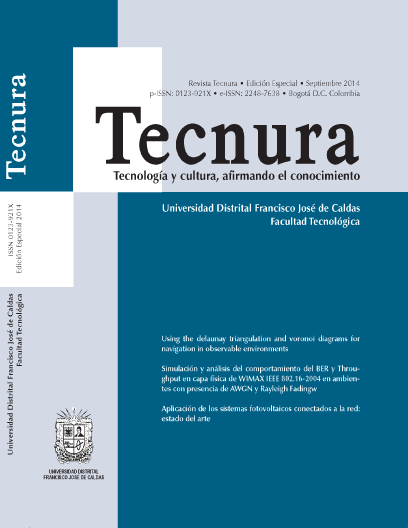DOI:
https://doi.org/10.14483/udistrital.jour.tecnura.2014.SE1.a10Published:
2014-12-01Issue:
Vol. 18 (2014): Special EditionSection:
ResearchEvaluación de los protocolos MAC IEEE 802.11 y MMAC-CR en una red manet
Evaluation of MAC IEEE 802.11 and MMAC-CR protocols within a manet
Downloads
Abstract (es)
Este artículo presenta un análisis comparativo entre los mecanismos de control de acceso al medio IEEE 802.11 y MMAC-CR (Multichannel MAC protocol for Cognitive Radio) en redes MANET (Mobile Ad Hoc Networks). El estándar IEEE 802.11 permite el uso de múltiples canales disponibles en la capa física, pero su protocolo MAC está diseñado para un solo canal. Sin embargo, un protocolo MAC de un solo canal no trabaja bien en un entorno multicanal debido al problema del terminal oculto. La metodología del artículo se basa en la descripción de los protocolos de control de acceso al medio, la simulación del throughput de estos, el análisis de los resultados y las conclusiones. Los resultados de simulación muestran cómo el protocolo MMAC-CR permite hacer un mejor uso de las oportunidades espectrales, incrementando de esta manera el throughput de la red MANET.
Abstract (en)
This paper presents a comparative analysis between the mechanisms associated to Media Access Control (MAC) IEEE 802.11 and MMAC-CR (Multichannel MAC protocol for Cognitive Radio) in MANETs (Mobile Ad Hoc Networks). The IEEE 802.11 standard allows the use of multiple channels available at the physical layer, but its MAC protocol is designed for a single channel. However, a single channel MAC protocol does not operate properly in a multi-channel environment due to the hidden terminal problem. The methodology of the article is based on the description of MAC protocols, including throughput simulations, results analysis and some conclusions. The simulation results show how the MMAC-CR protocol allows a better use of spectral opportunities, thereby increasing throughput on the MANET network.
References
Bano, N.; Roppel, T., and Gokhale I. (Mar. 2010). Use of mobility models for communication in collaborative robotics. Proceedings of System Theory (SSST), pp. 143-146.
BonnMotion, A mobility scenario generation and analysis tool.
http://sys.cs.uos.de/bonnmotion/index.shtml, Fecha de consulta: marzo 2012.
De Domenico, A.; Strinati, E., and Di Benedetto, M. (2012). A survey on MAC strategies for cognitive radio networks. IEEE Communications Surveys & Tutorials, vol. 14, No. 1, pp. 21-44.
Federal Comunications Commisions (FCC). Topic 10: License-Exempt wireless applications for public safety.
http://transition.fcc.gov/pshs/techtopics/techtopics10.html, Fecha de consulta: mayo de 2012.
Guevara J.; Pedraza L.; Hernández C. Evolución del protocolo MAC multicanal para redes de radio cognitiva. Tecnura, vol. 17, No. 36, 2013, pp.129-139.
Koes, M.; Nourbakhsh I., and Sycara K. Communication efficiency in multi-agent systems. Proceedings of IEEE International Conference on Robotics and Automation (ICRA ’04), vol. 3, May 2004, pp. 2129-2134.
National Science Foundation (NSF). Cognitive radio cognitive network simulator. http://faculty.uml.edu/Tricia_Chigan/Research/CRCN_Simulator.htm, Fecha de consulta: noviembre 2011.
Perkins, C., and Royer, E. Ad-hoc on-demand distance vector routing. Second IEEE Workshop on WMCSA '99, Feb. 1999, pp.90-100.
So, J., and Vaidya, N. Multi-channel MAC for ad hoc networks. Proceedings of MobiHoc '04, 2004, pp. 222-233.
Timmers, M.; Pollin, S.; Dejonghe, A.; Van der Perre L., and Catthoor, F. A distributed multichannel MAC protocol formultihop cognitive radio networks. IEEE Transactions on Vehicular Technology, vol. 59, No. 1, Jan. 2010, pp. 446-459.
UC Berkeley, LBL, USC/ISI, and Xerox PARC. The network simulator-ns-2. http://isi.edu/nsnam/ns/, Fecha de consulta: febrero 2012.
How to Cite
APA
ACM
ACS
ABNT
Chicago
Harvard
IEEE
MLA
Turabian
Vancouver
Download Citation
License
Esta licencia permite a otros remezclar, adaptar y desarrollar su trabajo incluso con fines comerciales, siempre que le den crédito y concedan licencias para sus nuevas creaciones bajo los mismos términos. Esta licencia a menudo se compara con las licencias de software libre y de código abierto “copyleft”. Todos los trabajos nuevos basados en el tuyo tendrán la misma licencia, por lo que cualquier derivado también permitirá el uso comercial. Esta es la licencia utilizada por Wikipedia y se recomienda para materiales que se beneficiarían al incorporar contenido de Wikipedia y proyectos con licencias similares.



